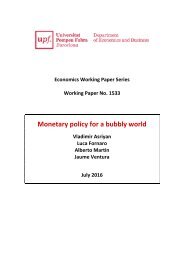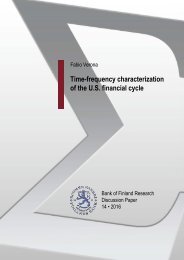Necessity as the mother of invention monetary policy after the crisis
n?u=RePEc:dnb:dnbwpp:525&r=mac
n?u=RePEc:dnb:dnbwpp:525&r=mac
You also want an ePaper? Increase the reach of your titles
YUMPU automatically turns print PDFs into web optimized ePapers that Google loves.
Table 11. Determinants <strong>of</strong> changes in central bank communication<br />
Communicated more<br />
Will communicate more<br />
Had internal mandate discussions 0.215* -0.005<br />
(0.119) -0.118<br />
Adopted macro-prudential tools 0.265** -0.067<br />
(0.133) -0.696<br />
Hit by <strong>crisis</strong> 0.220* -0.059<br />
(0.131) (0.6.12)<br />
Observations 54 38<br />
Pseudo R 2 0.123 0.005<br />
Notes: The table reports marginal effects <strong>of</strong> an ordered probit model that explains governors’<br />
responses <strong>as</strong> to <strong>the</strong> change in central bank communication during <strong>the</strong> <strong>crisis</strong> and <strong>the</strong> expected future<br />
developments. Coefficients are for <strong>the</strong> highest category (i.e., “much more” and “go even fur<strong>the</strong>r”).<br />
Numbers in brackets denote robust standard errors. */** identifies statistical significance at <strong>the</strong><br />
10%/5% level. Source: Authors’ calculations b<strong>as</strong>ed on survey among central bank governors<br />
conducted in 2016.<br />
4.4. Forward guidance<br />
The most prominent change in central bank communications h<strong>as</strong> been <strong>the</strong> more<br />
widespread use <strong>of</strong> forward guidance (FG), especially when interest rates are constrained<br />
at <strong>the</strong>ir (perceived) lower bound. Under FG, <strong>the</strong> central bank communicates not only about<br />
<strong>the</strong> current setting <strong>of</strong> <strong>monetary</strong> <strong>policy</strong>, but makes explicit statements about <strong>the</strong> future path<br />
<strong>of</strong> <strong>policy</strong>. While FG predates <strong>the</strong> <strong>crisis</strong>, most prominently in New Zealand, it h<strong>as</strong> become<br />
much more common since. The re<strong>as</strong>on is straightforward. Monetary <strong>policy</strong> works not only<br />
through <strong>the</strong> current setting <strong>of</strong> <strong>policy</strong> instruments, but also through expectations about <strong>the</strong><br />
future course <strong>of</strong> <strong>policy</strong>, which affects, among o<strong>the</strong>r things, <strong>the</strong> yield curve. Management<br />
<strong>of</strong> <strong>the</strong>se expectations can <strong>the</strong>refore be a powerful tool once <strong>the</strong> central bank h<strong>as</strong> already<br />
lowered short-term rates <strong>as</strong> much <strong>as</strong> it can (or wants to).<br />
Academic <strong>the</strong>ories <strong>of</strong>ten translate FG into true commitment on behalf <strong>of</strong> <strong>the</strong> central bank<br />
(cf. Eggertsson and Woodford, 2003). In <strong>the</strong> terminology <strong>of</strong> Campbell et al. (2012), FG is<br />
“Odyssean.” In practice, however, FG does not commit <strong>the</strong> central bank to anything<br />
(Moessner et al., 2016). Ra<strong>the</strong>r, it falls under Campbell et al. (2012)’s cl<strong>as</strong>sification <strong>as</strong><br />
“Delphic,” that is, FG merely forec<strong>as</strong>ts <strong>the</strong> central bank’s future behavior, with at most a<br />
conditional commitment that depends on macroeconomic developments. Of course,<br />
conveying that conditionality to markets h<strong>as</strong> proven challenging.<br />
Following Filardo and H<strong>of</strong>mann (2014), FG can be cl<strong>as</strong>sified into three different<br />
categories<br />
Qualitative FG does not provide exact indications <strong>as</strong> to when or under what<br />
conditions <strong>the</strong> central bank would change its <strong>policy</strong> rate. For example, in July 2013,<br />
27








